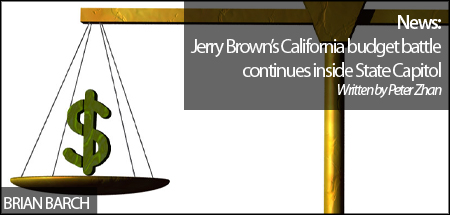
California K-12 schools could face severe budget restrictions for the upcoming school year as the state legislature tries to cut spending. In January, Governor Jerry Brown proposed a tax extension that would soften the effects of the cuts to education, but had difficulty getting his resolution approved for a June ballot, putting the funding situation for K-12 schools in limbo.
A recent Bloomberg News article stated that Brown is still trying to erase California’s remaining $15.4 billion deficit. According to the Contra Costa Times, Governor Brown proposed a budget in January that would spare K-12 schools the most severe cuts possible. However, his budget was dependent on voters passing a proposition that would extend expiring taxes another five years.
The governor had been having difficulties with getting his proposition on the June ballot.
He missed his self-set deadline, March 10, for the approval of the tax extension, and according to the Contra Costa Times, Jerry Brown was working to gather the two-thirds support he needed in the Legislature to carry on with his proposal for a tax extension on the June ballot, which voters would need to pass to reduce the cuts in education. He needed two Republicans in the Senate and two Republicans in the Assembly to reach the required votes.
According to Bloomberg News, “Last month, Brown said he had broken off negotiations for a statewide vote after being presented with a widening list of Republican demands.” He announced that he would release a new budget May 14.
“Without the passage of the June tax extension, districts are expecting to lose $330 to $1,000 per student depending on estimates by various school officials,” a recent Daily Journal article reported. If Jerry Brown’s proposed tax extensions were passed, these figures would be lowered to about $19 less per student.
According to Bloomberg News, Brown wants voters to vote for slight increases in personal income-tax rates, the retail-sales tax, auto-registration fees, and a substantial reduction of California’s child tax credit.
Principal Patricia Kurtz explains in more detail, “To tell you the truth, nobody knows exactly what is going to happen. Every day some new information comes out. Just today, I learned that since Jerry Brown can’t garner the support he needs for this June ballot, he might consider putting a proposition on the November ballot.
Although this news does not bode well for some California school districts, Kurtz is not overly worried. “Our high school district is usually stable regarding funding. Also, we’re a basic aid district, which means most of our money comes from local property taxes, not from the state government. Furthermore, we have adequate reserves to carry us through if needed.” Among teachers, only “temporary” teachers have been given pink slips this year.
Contrastingly, the San Mateo-Foster City school district, which covers elementary and middle schools, has been sustaining sizable reductions in budget. In a letter sent to staff and parents a few months ago, Pendery A. Clark, superintendent of the SMFC school district, noted, “The San Mateo-Foster City School District has absorbed over $21 million worth of staffing and program reductions over the past four years. We will need to make additional cuts this year and will be required to plan for the worst case scenario until we know for sure what happens with the June election.”
The San Jose Mercury News reports that the San Mateo-Foster City school district will be one of the hardest hit, with around 80 teachers receiving notices of possible layoffs, out of 540 full-time equivalents. “The layoffs would save the district a total of $5.3 million — $2.9 million in the general fund and $2.4 million in categorical expenses.”
According to the California Teachers Association, 1,200 Bay Area teachers were projected to receive notices of possible layoffs.
Public opinion on Jerry Brown’s budget seems to be divided. According to a poll conducted by the Public Policy Institute of California, “While two-thirds of all adults (67%) and likely voters (66%) said in January that a special election was a good idea, 54 percent of all adults and half of likely voters (51%) [said] so [in March].”
Student opinion is likewise divided. Senior Nicole Smith said, “Although budget cuts for education are bad, and schools need money to allow students to explore new things, I think that under the circumstances, budget cuts in education may be appropriate. However, I wouldn’t take as much money from the schools as they are.”
“One of the problems,” Kurtz said, “is that schools have to submit their budgets for the next year by June 30 to be certified by the county office of education and for state approval. Most schools are currently preparing two budgets—one for the worst case scenario and another for a more pleasant one. But it’s difficult to decide which budget to send in if the issue is sill undecided.”
It remains to be seen what becomes of the education budget for the next school year.

